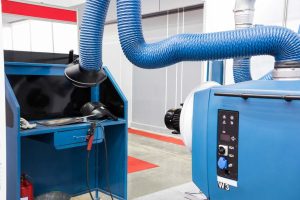 The UK has a strong framework and reputation when it comes to health and safety and the approach towards airborne contaminants is no exception. In 2022, there was an estimated 19,000 new cases of breathing or lung problems made worse by work, according to the HSE.
The UK has a strong framework and reputation when it comes to health and safety and the approach towards airborne contaminants is no exception. In 2022, there was an estimated 19,000 new cases of breathing or lung problems made worse by work, according to the HSE.
The primary legislation that addresses harmful airborne contaminants in the workplace is the Control of Substances Hazardous to Health Regulations (COSHH) which outlines that employers have a legal duty to access risks associated with hazardous substances and make decisions on what measures to use to protect the health of their employees. It is important that employers are engaged with airborne hazard safety not only for the health of their employees but to also avoid enforcement action.
As a result, some industries are more susceptible to the presence of harmful substances such as construction, manufacturing, and mining. Manufacturing roles such as brick and tile manufacture, ceramics and stone working and foundry work are particularly prone to harmful effects.
Airborne contaminants can occur from a variety of outputs depending on the occupational setting via substances such as dust, gases, fumes, mists, or vapours present in the air.
Even dusts created by foodstuffs that we consider to be safe can be hazardous, if there is continuous exposure. Output is often invisible to the naked eye, and workers are not aware that they are exposed.
Every year, thousands of workers in the UK experience damaging lung-related effects from airborne contaminants such as lung cancer, asthma or lung scarring because of airborne contaminants they have breathed in at work. The severity of harmful effects will ultimately depend on duration, frequency and degree of exposure to the substances.
As a result of the variety of airborne contaminant transmission and the often-imperceptible output, the HSE has identified a concerning trend: that employers are often unaware that their workers are being exposed to hazardous substances or that their existing controls may be insufficient.
This lack of awareness gives rise to several issues including the sources of exposure being missed, the deterioration of existing controls and incorrect utilisation of the implemented safeguards.
There is a systematic approach to installing LEV in the workplace to make sure that it is fit for purpose and effective. All LEV systems must comply with the Health and Safety at Work Act 1974 (HSWA) and the Control of Substances Hazardous to Health Regulations 2002 (COSHH).
You must manage LEV risk assessment properly; Safety First carries out LEV inspection and testing in the workplace to help companies ensure that they are fully compliant with COSHH regulations. Our qualified occupational hygienists are experts in local exhaust ventilation systems. They will monitor and analyse system performance data, as well as perform qualitative evaluations on the control of potential contaminants. Measurements from the test results are compared with the original LEV specification and performance criteria outlined in HSG258.
Regular inspections of LEV systems should take place to ensure the smooth running of the device.
Safety First’s LEV inspection and testing
Safety First will produce reports and records that will assist your business in improving control measures, plus serve as evidence of your company’s compliance with COSHH regulations.
Contact us should you require further information.